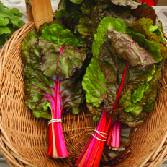-
CATEGORY ::
- All Seeds /
- All Flower Seeds /
- All Hollyhock Seeds




Hollyhock Seeds - Double White
SEASON
Perennial
USDA ZONES
4 - 9
HEIGHT
60 - 84 inches
BLOOM SEASON
Early to mid Summer
BLOOM COLOR
White
ENVIRONMENT
Full sun
SOIL TYPE
Well drained, pH 6.1 - 7.8
DEER RESISTANT
Yes
HOUSE PLANT
No
SEASON
Annual
USDA ZONES
3 - 9
HEIGHT
48 - 72 inches
BLOOM SEASON
Summer
BLOOM COLOR
Mix
ENVIRONMENT
Full sun
SOIL TYPE
Well drained, pH 6.1 - 7.8
DEER RESISTANT
Yes
HOUSE PLANT
No
AAS WINNER
1939
SEASON
Perennial
USDA ZONES
3 - 9
HEIGHT
72 inches
BLOOM SEASON
Early to late summer
BLOOM COLOR
Mix
ENVIRONMENT
Full sun
SOIL TYPE
Well drained, pH 6.1 - 7.8
DEER RESISTANT
Yes
SEASON
Perennial
USDA ZONES
4 - 9
HEIGHT
60 - 84 inches
BLOOM SEASON
Early to mid summer
BLOOM COLOR
Pink
ENVIRONMENT
Full sun
SOIL TYPE
Well drained, pH 6.1 - 7.8
DEER RESISTANT
Yes
SEASON
Perennial
USDA ZONES
4 - 9
HEIGHT
60 - 84 inches
BLOOM SEASON
Early to mid Summer
BLOOM COLOR
Yellow
ENVIRONMENT
Full sun
SOIL TYPE
Well drained, pH 6.1 - 7.8
DEER RESISTANT
Yes
SEASON
Perennial
USDA ZONES
4 - 8
HEIGHT
60 inches
BLOOM SEASON
Summer
BLOOM COLOR
Purple
ENVIRONMENT
Full sun to partial shade
SOIL TYPE
Well-drained, pH 5.8 - 7.2
DEER RESISTANT
Yes
SEASON
Perennial
USDA ZONES
3 - 9
HEIGHT
72 inches
BLOOM SEASON
Early to late summer
BLOOM COLOR
Mix
ENVIRONMENT
Full sun
SOIL TYPE
Well drained, pH 6.1 - 7.8
DEER RESISTANT
Yes
SEASON
Perennial
USDA ZONES
3 - 9
HEIGHT
72 inches
BLOOM SEASON
Early to late summer
BLOOM COLOR
Red
ENVIRONMENT
Full sun
SOIL TYPE
Well drained, pH 6.1 - 7.8
DEER RESISTANT
Yes
About...
Hollyhock (Alcea Rosea Chaters Double White) - Hollyhock is an old time favorite for many gardeners. Chater's Double White Hollyhock is very colorful with bridght white double blossoms which contrast nicely with the light green foliage. It will bloom from early to midsummer reaching a height of 5 to 7 feet tall and 1 to 2 feet wide and grows best in full sun.MORE HOLLYHOCK OPTIONS
Planting Directions
TEMPERATURE
60 - 65F
AVERAGE GERM TIME
21 - 28 days
LIGHT REQUIRED
Yes
DEPTH
Do not cover the seed but press into the soil
SOWING RATE
2 - 3 seeds per plant
MOISTURE
Keep seeds moist until germination
PLANT SPACING
24 inches
Hollyhock (Alcea Rosea Chaters Double White) - Hollyhock is an old time favorite for many gardeners. Chater's Double White Hollyhock is very colorful with bridght white double blossoms which contrast nicely with the light green foliage. It will bloom from early to midsummer reaching a height of 5 to 7 feet tall and 1 to 2 feet wide and grows best in full sun.
Plant hollyhocks in a Cottage Garden or as a back border in a perennial garden. They have an impressive effect when planted in a mass planting. Hummingbirds, butterflies and bees are attracted to the flowers and deer tend to stay away from Hollyhocks. It has no real change in fall color and it will die back for the winter.































